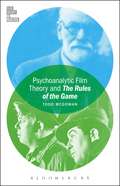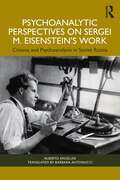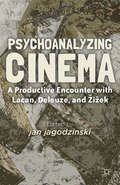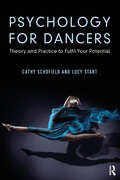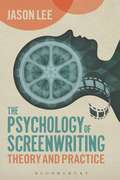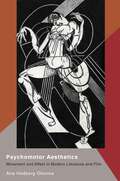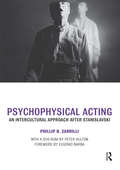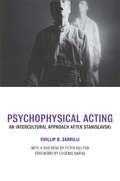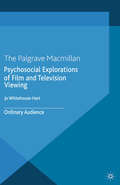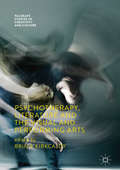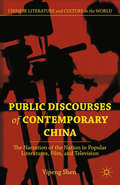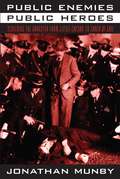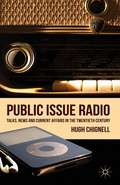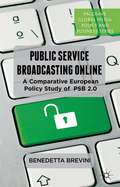- Table View
- List View
Psychoanalytic Film Theory and The Rules of the Game (Film Theory in Practice)
by Todd McGowanThe Film Theory in Practice Series fills a gaping hole in the world of film theory. By marrying the explanation of film theory with interpretation of a film, the volumes provide discrete examples of how film theory can serve as the basis for textual analysis. The first book in the series, Psychoanalytic Film Theory and The Rules of the Game, offers a concise introduction to psychoanalytic film theory in jargon-free language and shows how this theory can be deployed to interpret Jean Renoir's classic film. It traces the development of psychoanalytic film theory through its foundation in the thought of Sigmund Freud and Jacques Lacan through its contemporary manifestation in the work of theorists like Slavoj Žižek and Joan Copjec. This history will help students and scholars who are eager to learn more about this important area of film theory and bring the concepts of psychoanalytic film theory into practice through a detailed interpretation of the film.
Psychoanalytic Film Theory and The Rules of the Game (Film Theory in Practice)
by Todd McGowanThe Film Theory in Practice Series fills a gaping hole in the world of film theory. By marrying the explanation of film theory with interpretation of a film, the volumes provide discrete examples of how film theory can serve as the basis for textual analysis. The first book in the series, Psychoanalytic Film Theory and The Rules of the Game, offers a concise introduction to psychoanalytic film theory in jargon-free language and shows how this theory can be deployed to interpret Jean Renoir's classic film. It traces the development of psychoanalytic film theory through its foundation in the thought of Sigmund Freud and Jacques Lacan through its contemporary manifestation in the work of theorists like Slavoj Žižek and Joan Copjec. This history will help students and scholars who are eager to learn more about this important area of film theory and bring the concepts of psychoanalytic film theory into practice through a detailed interpretation of the film.
Psychoanalytic Perspectives on Sergei M. Eisenstein's Work: Cinema and Psychoanalysis in Soviet Russia
by Alberto AngeliniIn this insightful book, Alberto Angelini shows the influence of psychoanalysis and psychology on Sergei M. Eisenstein, one of the most celebrated Russian directors, and his cinematic output. Angelini situates Eisenstein’s life and oeuvre in the history and culture of twentieth-century Russia, drawing clear parallels between his networking with key figures such as Lev Vygotsky and Aleksandr Luria. He utilises the tools of psychology with the insight of psychoanalysis to illuminate the ways in which Eisenstein understood art as an anthropological enterprise while maintaining the same dialectical philosophy as the director in highlighting the many disciplines and figures that he drew inspiration from. Angelini also looks in depth at the influence psychoanalytic theories of regression had on Eisenstein’s approach to art, while examining the impact Stalinism had directly on both Eisenstein and psychoanalysis at large from the 1930s onwards. This book is an essential resource for psychoanalysts, students, and scholars of film studies, as well as those interested in the intersection between psychoanalytic theory, cinema, and the arts.
Psychoanalytic Perspectives on Sergei M. Eisenstein's Work: Cinema and Psychoanalysis in Soviet Russia
by Alberto AngeliniIn this insightful book, Alberto Angelini shows the influence of psychoanalysis and psychology on Sergei M. Eisenstein, one of the most celebrated Russian directors, and his cinematic output. Angelini situates Eisenstein’s life and oeuvre in the history and culture of twentieth-century Russia, drawing clear parallels between his networking with key figures such as Lev Vygotsky and Aleksandr Luria. He utilises the tools of psychology with the insight of psychoanalysis to illuminate the ways in which Eisenstein understood art as an anthropological enterprise while maintaining the same dialectical philosophy as the director in highlighting the many disciplines and figures that he drew inspiration from. Angelini also looks in depth at the influence psychoanalytic theories of regression had on Eisenstein’s approach to art, while examining the impact Stalinism had directly on both Eisenstein and psychoanalysis at large from the 1930s onwards. This book is an essential resource for psychoanalysts, students, and scholars of film studies, as well as those interested in the intersection between psychoanalytic theory, cinema, and the arts.
Psychoanalyzing Cinema: A Productive Encounter with Lacan, Deleuze, and Žižek
by Jan JagodzinskiThe essays within this collection explore the possibilities and potentialities of all three positions, presenting encounters that are, at times contradictory, at other times supportive, as well as complementary. The collection thereby enriches the questions that are being raised within contemporary cinematic studies.
Psychocinema (Theory Redux)
by Helen RollinsPsychocinema reexamines the connection between psychoanalysis and film, arguing for a return to the universalist core of both cinema and subjectivity. It traces the history of the influence of psychoanalysis on cinema and shows how the detour into ideologies of identity and difference eclipses the premise of the first and the emancipatory power of the second.The book argues that psychoanalysis does not simply help us elucidate what we see on screen: rather, there is a fundamental relationship between the structure of psychoanalysis and that of cinema. Cinema acts upon the viewer like psychoanalysis upon the analysand and can expose them to the universal Lack inherent in their desire. This process undermines the unconscious logic of capitalism, which relies on a promise in fulfilment.Rollins, a filmmaker, shows how reductive interpretations of psychoanalytic film theory have permeated film education and film practice and have affected the way films are made and watched, to the detriment of contemporary philosophy and politics. Psychocinema urges filmmakers, theorists and audiences to embrace the truly radical and emancipatory potential of cinema: its capacity to confront us with the universal Lack in our desire.
Psychology for Dancers: Theory and Practice to Fulfil Your Potential
by Cathy Schofield Lucy StartPsychology for Dancers: Theory and Practice to Fulfil Your Potential examines how psychological theory can be related to dance practice. Aimed at the dancer who wants to maximize their potential but has no grounding in psychology, the book begins with an examination of basic psychological concepts, approaches and methods, before applying theory to dance. The book explores why dance is so important in many people’s lives: as a form of fitness, a profession, or visual entertainment. Each chapter then examines a different aspect of psychology related to dance in an applied context. Self-perception is examined as dancers are under great scrutiny; a grounded sense of self will ensure a positive perception of self-worth and body image, and suggestions are made as to how a healthy and motivational climate can be created. The book also places an emphasis on how cognitive skills are as important as technical skills, including the ability to learn and recall steps and choreography as efficiently as possible. Social factors are related to the dance context, with a discussion of effective leadership and communication skills and the importance of group cohesion. Finally, there is a review of the impact of emotions on dance practice and how best to manage these emotions. Each chapter reviews important psychological theories, offering practical suggestions on how they can be applied to dance practice. Psychology for Dancers is an invaluable resource for students, professionals, and teachers of dance.
Psychology for Dancers: Theory and Practice to Fulfil Your Potential
by Cathy Schofield Lucy StartPsychology for Dancers: Theory and Practice to Fulfil Your Potential examines how psychological theory can be related to dance practice. Aimed at the dancer who wants to maximize their potential but has no grounding in psychology, the book begins with an examination of basic psychological concepts, approaches and methods, before applying theory to dance. The book explores why dance is so important in many people’s lives: as a form of fitness, a profession, or visual entertainment. Each chapter then examines a different aspect of psychology related to dance in an applied context. Self-perception is examined as dancers are under great scrutiny; a grounded sense of self will ensure a positive perception of self-worth and body image, and suggestions are made as to how a healthy and motivational climate can be created. The book also places an emphasis on how cognitive skills are as important as technical skills, including the ability to learn and recall steps and choreography as efficiently as possible. Social factors are related to the dance context, with a discussion of effective leadership and communication skills and the importance of group cohesion. Finally, there is a review of the impact of emotions on dance practice and how best to manage these emotions. Each chapter reviews important psychological theories, offering practical suggestions on how they can be applied to dance practice. Psychology for Dancers is an invaluable resource for students, professionals, and teachers of dance.
The Psychology of Screenwriting: Theory and Practice
by Jason LeeThe Psychology of Screenwriting is more than an interesting book on the theory and practice of screenwriting. It is also a philosophical analysis of predetermination and freewill in the context of writing and human life in our mediated world of technology. Drawing on humanism, existentialism, Buddhism, postmodernism and transhumanism, and diverse thinkers from Meister Eckhart to Friedrich Nietzsche, Theodor Adorno, Jacques Derrida, Jean Baudrillard and Gilles Deleuze, The Psychology of Screenwriting will be of use to screenwriters, film students, philosophers and all those interested in contemporary theory. This book combines in-depth critical and cultural analysis with an elaboration on practice in an innovative fashion. It explores how people, such as those in the Dogme 95 movement, have tried to overcome traditional screenwriting, looking in detail at the psychology of writing and the practicalities of how to write well for the screen. This is the first book to include high-theory with screenwriting practice whilst incorporating the Enneagram for character development. Numerous filmmakers and writers, including David Lynch, Jim Jarmusch, David Cronenberg, Pedro Almodóvar, Darren Aronofsky, Sally Potter and Charlie Kaufman are explored. The Psychology of Screenwriting is invaluable for those who want to delve deeper into writingfor the screen.
The Psychology of Screenwriting: Theory and Practice
by Jason LeeThe Psychology of Screenwriting is more than an interesting book on the theory and practice of screenwriting. It is also a philosophical analysis of predetermination and freewill in the context of writing and human life in our mediated world of technology. Drawing on humanism, existentialism, Buddhism, postmodernism and transhumanism, and diverse thinkers from Meister Eckhart to Friedrich Nietzsche, Theodor Adorno, Jacques Derrida, Jean Baudrillard and Gilles Deleuze, The Psychology of Screenwriting will be of use to screenwriters, film students, philosophers and all those interested in contemporary theory. This book combines in-depth critical and cultural analysis with an elaboration on practice in an innovative fashion. It explores how people, such as those in the Dogme 95 movement, have tried to overcome traditional screenwriting, looking in detail at the psychology of writing and the practicalities of how to write well for the screen. This is the first book to include high-theory with screenwriting practice whilst incorporating the Enneagram for character development. Numerous filmmakers and writers, including David Lynch, Jim Jarmusch, David Cronenberg, Pedro Almodóvar, Darren Aronofsky, Sally Potter and Charlie Kaufman are explored. The Psychology of Screenwriting is invaluable for those who want to delve deeper into writingfor the screen.
Psychomotor Aesthetics: Movement and Affect in Modern Literature and Film
by Ana Hedberg OleninaIn the late 19th century, modern psychology emerged as a discipline, shaking off metaphysical notions of the soul in favor of a more scientific, neurophysiological concept of the mind. Laboratories began to introduce instruments and procedures which examined bodily markers of psychological experiences, like muscle contractions and changes in vital signs. Along with these changes in the scientific realm came a newfound interest in physiological psychology within the arts - particularly with the new perception of artwork as stimuli, able to induce specific affective experiences. In Psychomotor Aesthetics, author Ana Hedberg Olenina explores the effects of physiological psychology on art at the turn of the 20th century. The book explores its influence on not only art scholars and theorists, wishing to understand the relationship between artistic experience and the internal processes of the mind, but also cultural producers more widely. Actors incorporated psychology into their film acting techniques, the Russian and American film industries started to evaluate audience members' physical reactions, and literary scholars began investigations into poets' and performers' articulation. Yet also looming over this newly emergent field were commercial advertisers and politicians, eager to use psychology to further their own mass appeal and assert control over audiences. Drawing from archival documents and a variety of cross-disciplinary sources, Psychomotor Aesthetics calls attention to the cultural resonance of theories behind emotional and cognitive experience - theories with implications for today's neuroaesthetics and neuromarketing.
PSYCHOMOTOR AESTHETICS C: Movement and Affect in Modern Literature and Film
by Ana Hedberg OleninaIn the late 19th century, modern psychology emerged as a discipline, shaking off metaphysical notions of the soul in favor of a more scientific, neurophysiological concept of the mind. Laboratories began to introduce instruments and procedures which examined bodily markers of psychological experiences, like muscle contractions and changes in vital signs. Along with these changes in the scientific realm came a newfound interest in physiological psychology within the arts - particularly with the new perception of artwork as stimuli, able to induce specific affective experiences. In Psychomotor Aesthetics, author Ana Hedberg Olenina explores the effects of physiological psychology on art at the turn of the 20th century. The book explores its influence on not only art scholars and theorists, wishing to understand the relationship between artistic experience and the internal processes of the mind, but also cultural producers more widely. Actors incorporated psychology into their film acting techniques, the Russian and American film industries started to evaluate audience members' physical reactions, and literary scholars began investigations into poets' and performers' articulation. Yet also looming over this newly emergent field were commercial advertisers and politicians, eager to use psychology to further their own mass appeal and assert control over audiences. Drawing from archival documents and a variety of cross-disciplinary sources, Psychomotor Aesthetics calls attention to the cultural resonance of theories behind emotional and cognitive experience - theories with implications for today's neuroaesthetics and neuromarketing.
Psychophysical Acting: An Intercultural Approach after Stanislavski
by Phillip B. ZarrilliPsychophysical Acting is a direct and vital address to the demands of contemporary theatre on today’s actor. Drawing on over thirty years of intercultural experience, Phillip Zarrilli aims to equip actors with practical and conceptual tools with which to approach their work. Areas of focus include: an historical overview of a psychophysical approach to acting from Stanislavski to the present acting as an ‘energetics’ of performance, applied to a wide range of playwrights: Samuel Beckett, Martin Crimp, Sarah Kane, Kaite O’Reilly and Ota Shogo a system of training though yoga and Asian martial arts that heightens sensory awareness, dynamic energy, and in which body and mind become one practical application of training principles to improvisation exercises. Psychophysical Acting is accompanied by Peter Hulton’s interactive DVD-ROM featuring exercises, production documentation, interviews, and reflection.
Psychophysical Acting: An Intercultural Approach after Stanislavski
by Phillip B. ZarrilliPsychophysical Acting is a direct and vital address to the demands of contemporary theatre on today’s actor. Drawing on over thirty years of intercultural experience, Phillip Zarrilli aims to equip actors with practical and conceptual tools with which to approach their work. Areas of focus include: an historical overview of a psychophysical approach to acting from Stanislavski to the present acting as an ‘energetics’ of performance, applied to a wide range of playwrights: Samuel Beckett, Martin Crimp, Sarah Kane, Kaite O’Reilly and Ota Shogo a system of training though yoga and Asian martial arts that heightens sensory awareness, dynamic energy, and in which body and mind become one practical application of training principles to improvisation exercises. Psychophysical Acting is accompanied by Peter Hulton’s interactive DVD-ROM featuring exercises, production documentation, interviews, and reflection.
Psychosocial Explorations of Film and Television Viewing: Ordinary Audience (Studies in the Psychosocial)
by Jo Whitehouse-HartMost people have, at some point, experienced powerful, often strange and disconcerting, responses to films and television programmes of which they cannot always make sense. Drawing on insights from psychoanalysis, this book argues that the seemingly mundane and everyday activity of film and television viewing in the home is in fact extraordinary.
Psychotherapy, Literature and the Visual and Performing Arts (Palgrave Studies in Creativity and Culture)
by Bruce KirkcaldyThis book explores the relevance of literature and the performing and visual arts for effective clinical psychotherapy. There is a growing interest in the use of the arts in psychotherapy, in part due to an increasing awareness of the limitations in verbal communication and scepticism towards traditional forms of medical treatment. Gathering together perspectives from international practitioners this volume embraces the value of a range of mediums to psychotherapy, from film and photo-therapy to literature and narrative therapy. Based on theoretical studies, clinical expertise and experiential learning, authors offer detailed guidelines on the value of various art forms in practice.
Psychotherapy, Literature and the Visual and Performing Arts (Palgrave Studies in Creativity and Culture)
by Bruce KirkcaldyThis book explores the relevance of literature and the performing and visual arts for effective clinical psychotherapy. There is a growing interest in the use of the arts in psychotherapy, in part due to an increasing awareness of the limitations in verbal communication and scepticism towards traditional forms of medical treatment. Gathering together perspectives from international practitioners this volume embraces the value of a range of mediums to psychotherapy, from film and photo-therapy to literature and narrative therapy. Based on theoretical studies, clinical expertise and experiential learning, authors offer detailed guidelines on the value of various art forms in practice.
Public Discourses of Contemporary China: The Narration of the Nation in Popular Literatures, Film, and Television (Chinese Literature and Culture in the World)
by Y. ShenAnalyzing contemporary Chinese literature, film, and television, Shen shows the significance of nationalism for the mass imagination in post-socialist China. Chapters move from the intellectual idealism of the 1980s, through the post-Tiananmen transition, to the national cinema of the 1990s, and finally to the Internet literature of today.
Public Enemies, Public Heroes: Screening the Gangster from Little Caesar to Touch of Evil
by Jonathan MunbyIn this study of Hollywood gangster films, Jonathan Munby examines their controversial content and how it was subjected to continual moral and political censure. Beginning in the early 1930s, these films told compelling stories about ethnic urban lower-class desires to "make it" in an America dominated by Anglo-Saxon Protestant ideals and devastated by the Great Depression. By the late 1940s, however, their focus shifted to the problems of a culture maladjusting to a new peacetime sociopolitical order governed by corporate capitalism. The gangster no longer challenged the establishment; the issue was not "making it," but simply "making do." Combining film analysis with archival material from the Production Code Administration (Hollywood's self-censoring authority), Munby shows how the industry circumvented censure, and how its altered gangsters (influenced by European filmmakers) fueled the infamous inquisitions of Hollywood in the postwar '40s and '50s by the House Committee on Un-American Activities. Ultimately, this provocative study suggests that we rethink our ideas about crime and violence in depictions of Americans fighting against the status quo.
Public Images: Celebrity, Photojournalism, and the Making of the Tabloid Press (Photography, History: History, Photography)
by Ryan LinkofThe stolen snapshot is a staple of the modern tabloid press, as ubiquitous as it is notorious. The first in-depth history of British tabloid photojournalism, this book explores the origin of the unauthorised celebrity photograph in the early 20th century, tracing its rise in the 1900s through to the first legal trial concerning the right to privacy from photographers shortly after the Second World War. Packed with case studies from the glamorous to the infamous, the book argues that the candid snap was a tabloid innovation that drew its power from Britain's unique class tensions. Used by papers such as the Daily Mirror and Daily Sketch as a vehicle of mass communication, this new form of image played an important and often overlooked role in constructing the idea of the press photographer as a documentary eyewitness. From Edward VIII and Wallis Simpson to aristocratic debutantes Lady Diana Cooper and Margaret Whigham, the rage of the social elite at being pictured so intimately without permission was matched only by the fascination of working class readers, while the relationship of the British press to social, economic and political power was changed forever.Initially pioneered in the metropole, tabloid-style photojournalism soon penetrated the journalistic culture of most of the globe. This in-depth account of its social and cultural history is an invaluable source of new research for historians of photography, journalism, visual culture, media and celebrity studies.
Public Images: Celebrity, Photojournalism, and the Making of the Tabloid Press (Photography, History: History, Photography)
by Ryan LinkofThe stolen snapshot is a staple of the modern tabloid press, as ubiquitous as it is notorious. The first in-depth history of British tabloid photojournalism, this book explores the origin of the unauthorised celebrity photograph in the early 20th century, tracing its rise in the 1900s through to the first legal trial concerning the right to privacy from photographers shortly after the Second World War. Packed with case studies from the glamorous to the infamous, the book argues that the candid snap was a tabloid innovation that drew its power from Britain's unique class tensions. Used by papers such as the Daily Mirror and Daily Sketch as a vehicle of mass communication, this new form of image played an important and often overlooked role in constructing the idea of the press photographer as a documentary eyewitness. From Edward VIII and Wallis Simpson to aristocratic debutantes Lady Diana Cooper and Margaret Whigham, the rage of the social elite at being pictured so intimately without permission was matched only by the fascination of working class readers, while the relationship of the British press to social, economic and political power was changed forever.Initially pioneered in the metropole, tabloid-style photojournalism soon penetrated the journalistic culture of most of the globe. This in-depth account of its social and cultural history is an invaluable source of new research for historians of photography, journalism, visual culture, media and celebrity studies.
Public Issue Radio: Talks, News and Current Affairs in the Twentieth Century
by H. ChignellBased on original and previously unseen written and sound archives and interviews with former and current radio producers and presenters, Public Issue Radio addresses the controversial question of the political leanings of current affairs programmes, and asks if Analysis became an early platform for both Thatcherite and Blairite ideas.
Public Service Broadcasting 3.0: Legal Design for the Digital Present (Routledge Research in Media Law)
by Mira BurriThe digital media environment is characterized by an abundance and diversity of content, a multiplicity of platforms, new modes of content production, distribution and access, and changed patterns of consumer and business behaviour. This has challenged the traditional model of public service broadcasting (PSB) in diverse ways. This book explores whether and how PSB should adapt to reflect the conditions of the digital media space so that it can effectively and efficiently continue to serve its public mandate. Drawing on literature on media governance in media and communication science, public international law as well as discussions on cyberlaw, Mira Burri maps and critically analyses existing policy and scholarly debates on PSB transformation. She challenges some of conventional rationales for reform, identifies new ones, as well as exposes the limitations placed upon existing and future policy solutions by global media governance arrangements, especially in the fields of trade, copyright and Internet governance. The book goes on to advance a future-oriented model of Public Service Media, which is capable of matching an environment of technological and of governance complexity. As a work that explores how public interest objectives can be pursued efficiently and sustainably in the digital media ecology, this book will be of great interest and use to students and researchers in media law, information technology law, and broadcast media studies, as well as to policy-makers.
Public Service Broadcasting 3.0: Legal Design for the Digital Present (Routledge Research in Media Law #8)
by Mira BurriThe digital media environment is characterized by an abundance and diversity of content, a multiplicity of platforms, new modes of content production, distribution and access, and changed patterns of consumer and business behaviour. This has challenged the traditional model of public service broadcasting (PSB) in diverse ways. This book explores whether and how PSB should adapt to reflect the conditions of the digital media space so that it can effectively and efficiently continue to serve its public mandate. Drawing on literature on media governance in media and communication science, public international law as well as discussions on cyberlaw, Mira Burri maps and critically analyses existing policy and scholarly debates on PSB transformation. She challenges some of conventional rationales for reform, identifies new ones, as well as exposes the limitations placed upon existing and future policy solutions by global media governance arrangements, especially in the fields of trade, copyright and Internet governance. The book goes on to advance a future-oriented model of Public Service Media, which is capable of matching an environment of technological and of governance complexity. As a work that explores how public interest objectives can be pursued efficiently and sustainably in the digital media ecology, this book will be of great interest and use to students and researchers in media law, information technology law, and broadcast media studies, as well as to policy-makers.
Public Service Broadcasting Online: A Comparative European Policy Study of PSB 2.0 (Palgrave Global Media Policy and Business)
by B. BreviniThis book investigates the extent to which a Public Service Broadcasting (PSB) ethos has been extended to the online world in Europe. It examines the most significant policy initiatives carried out by PSBs in Europe on online platforms, and analyzes how the public service philosophy is being reinvented by policy makers.
